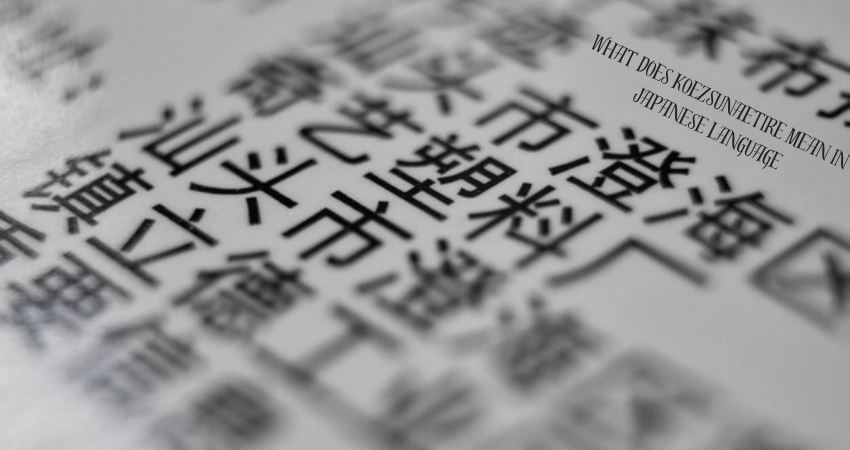Language is a powerful tool that reflects culture, history, and innovation. Occasionally, unfamiliar terms like “koezsunaetire” arise, sparking curiosity about their origins and meaning. Although this term is not recognized in Japanese dictionaries or common usage, analyzing its structure and potential context provides insights into the flexibility and adaptability of the Japanese language.
This article delves into the possible interpretations of “what does koezsunaetire mean in japanese language,” explores its compatibility with Japanese phonetics and grammar, and discusses how new or foreign words are absorbed into Japanese.
Overview of the Japanese Language
what does koezsunaetire mean in japanese language any unfamiliar term, it’s essential to grasp the fundamentals of the language being analyzed.
Structure and Writing Systems
Japanese uses three primary writing systems:
- Kanji: Logographic characters borrowed from Chinese.
- Hiragana: Phonetic characters used for native words and grammatical elements.
- Katakana: Phonetic characters used for foreign words and emphasis.
Phonetics and Syllables in Japanese
The Japanese language is syllabic, meaning words are constructed from combinations of distinct syllables. Japanese syllables are generally formed with a consonant-vowel structure, such as ka, ki, ku, ke, ko. Terms like “koezsunaetire” do not naturally align with this pattern, raising questions about its origins or whether it is a transliteration.

Loanwords and Transliteration
Modern Japanese has absorbed numerous foreign words, adapting them into its phonetic system. For example, “computer” becomes (konpyūta). If “koezsunaetire” is of foreign origin, it might be an attempt to fit into the Japanese phonetic system.
Analysis of “Koezsunaetire”
Breaking Down the Term
The term “koezsunaetire” can be divided into syllables to evaluate its compatibility with Japanese phonetics:
- Koe : Means “voice” in Japanese.
- Zu : Often indicates possession or action.
- Nae : Can mean “seedling” or “young plant.”
- Tire : Phonetic, but does not correspond to a known word.
Evaluating Compatibility with Japanese
While parts of the term seem compatible with Japanese syllabic rules, the overall structure feels unnatural. For example, the sequence “zs” is not typical in native Japanese phonology.
Possible Alternate Spellings or Meanings
If the term “koezsunaetire” is misspelled, some plausible alternatives might include:
- Koe Tsunae Taire: Meaning something like “connect voices.”
- Koetsu Naetire: Could imply “overcoming seedlings” metaphorically.
Cultural Context of Naming in Japanese
Significance of Names
Names in Japanese often hold deep meaning, combining kanji to express aspirations, beauty, or historical significance. If “koezsunaetire” is a name or phrase, its interpretation could depend on its kanji representation.
Foreign Influence on Japanese Terminology
Foreign names, terms, and cultural elements frequently inspire new Japanese words. Examples include:
- Anime : From “animation.”
- Pan : From Portuguese “pão” (bread).
Historical Evolution of Japanese Words
Historical Periods and Language
The Japanese language evolved through various historical influences:
- Nara Period (710–794): Chinese influence introduced kanji.
- Heian Period (794–1185): Development of hiragana and katakana.
- Meiji Period (1868–1912): Western loanwords increased due to modernization.
Modernization and New Terms
With globalization, Japanese continues to absorb foreign terms, adapting them to fit native phonetics and cultural context.
Interpretation Challenges
Misheard or Mistranslated Terms
Sometimes, unfamiliar terms arise due to errors in pronunciation, hearing, or transliteration. “Koezsunaetire” might be an example of this phenomenon.
Adapting Foreign Terms
Foreign words often undergo significant phonetic changes to fit Japanese. For instance:
- Taxi → ー (takushī)
- Bread → (pan)
Related Words or Phrases in Japanese
Exploring similar-sounding terms may reveal connections:
- Koe: Voice.
- Tsunagu : To connect.
- Naeru : To wither or weaken.
These words suggest possible symbolic meanings related to communication, connection, or vitality.
Role of Japanese Dictionaries and Databases
Tools for Verification
Databases like Jisho.org and Kotobank can help identify rare or obscure terms. However, “koezsunaetire” does not appear in these sources, further confirming its obscurity.

The Internet and New Words
Coining Terms Online
The internet has become a breeding ground for linguistic experimentation. If “koezsunaetire” originated online, it might be a meme, fictional word, or user-generated term.
Conclusion
what does koezsunaetire mean in japanese language does not currently hold a recognized meaning in Japanese. Its structure suggests it may be a misinterpretation or an attempt at transliteration. This analysis highlights the complexities of understanding and integrating unfamiliar terms into the Japanese language. By studying such terms, we deepen our appreciation for linguistic and cultural diversity.


